Apple iOS 5 Review
by Vivek Gowri, Andrew Cunningham, Saumitra Bhagwat & Brian Klug on October 18, 2011 3:05 AM ESTiPhone 3G users may remember what using iOS 4.0 was like on those phones when it was first released - it reduced performance to the extent that fixing this slowness merited a bullet point during Apple's iOS 4.1 reveal, and we found that even that didn't fix all of the problems. Will iOS 5 make the older devices on the support list similarly slow, or can we upgrade without worrying?
iPhone 3GS and Third Generation iPod Touch
The iPhone 3GS came out just over two years ago, and while it's getting a little long in the tooth its performance under iOS 5 is pleasantly surprising. Generally speaking the 3GS seems to be running just as quickly as it did with iOS 4.3, and it’s missing just a handful of features included on higher-end devices: Location-based Reminders (on the 4 and 4S), WiFi Personal Hotspot (introduced for the Verizon iPhone 4 and extended to the GSM iPhone 4 in iOS 4.3, no doubt because the 3GS uses a BCM4325 for WiFi and the iPhone 4 uses a BCM4329), and Siri (an iPhone 4S exclusive) are among the most notable. 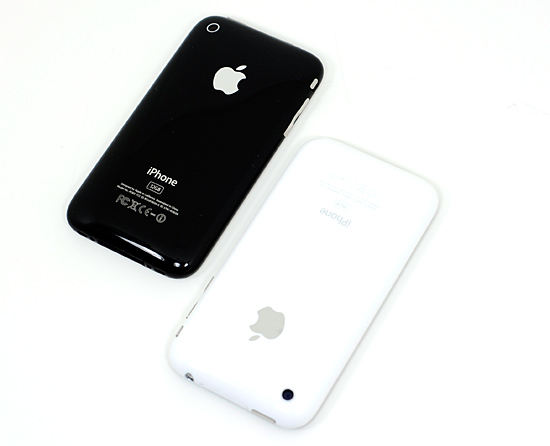
The big stuff is there, though, and it’s because the performance and feature gap between the 3GS and the rest of Apple’s lineup isn’t nearly as wide as the gap between the 3G and the then-current lineup at the time of iOS 4’s release. The 3GS’s Cortex A8 uses the same ARMv7 instruction set as the later A4 and A5 chips, while the 3G used the same ARMv6-capable Samsung S5L8900 SoC as the original iPhone. The 3GS has 256MB of RAM, the same as the original iPad and the currently-shipping fourth-gen iPod Touch, while the 3G had only 128MB. You get the picture - the 3GS’s upgrades relative to the 3G (which impressed us when the phone was originally released) has given it longer legs than its predecessor (and we’ll probably be saying similar things about the 4S in a couple of years).
We've already seen that JavaScript performance in Safari is better in iOS 5, but app launch times are another important metric. To get these numbers, we went back to our iOS 4.1 performance evaluation and repeated the same tests under the newer version. The phone was loaded with a fresh iOS 5 install, and all apps had been cleared from the multitasking tray. Our tests found that, most of the time, app launch speed was as fast or a bit faster than under iOS 4.1.
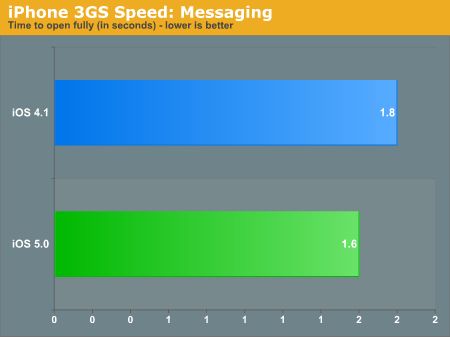
This is the time between when the Messages app was launched and when the app was ready for text entry. iOS 5 just edges out iOS 4.1 in this case.
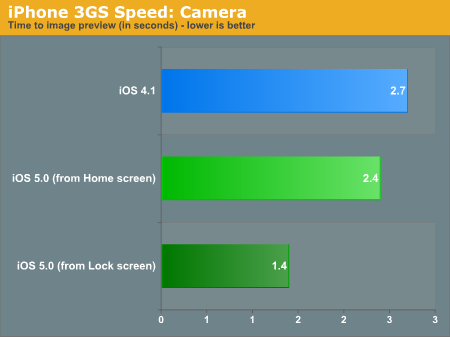
This is the time between when the Camera app was launched and when you could actually take pictures with it. From the Home screen, iOS 5 edges out iOS 4.1, and the time is consistently reduced by almost half when launched from the Lock screen - in order to reduce launch times, iOS 5 apparently does some preloading when the Home button is tapped twice (I also found this to be true on a fourth gen iPod Touch, though the difference was less pronounced).
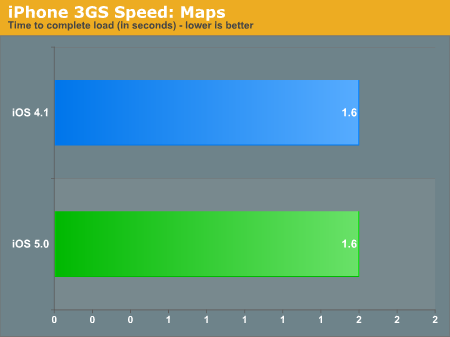
No changes here - the Maps app launches and is ready for input in the same amount of time as in iOS 4.1.
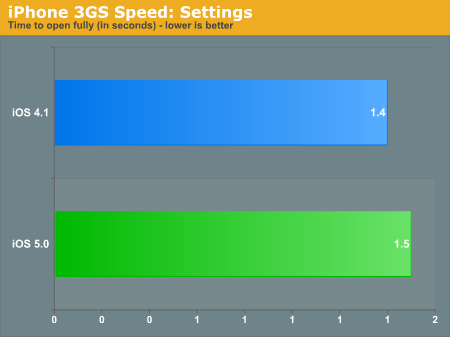
The Settings app launched slightly more slowly in iOS 5 than in iOS 4.1, but it's a change you'll notice only if you're timing it with a stopwatch.
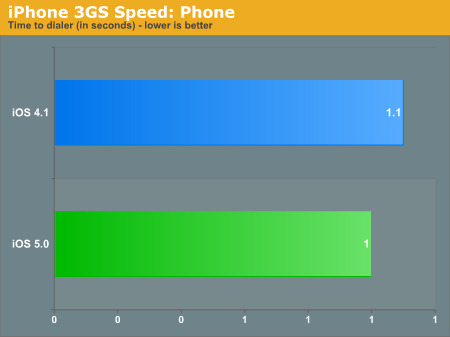
Another small variance from iOS 4.1 - in practice, the Phone dialer is ready to use pretty much instantaneously.
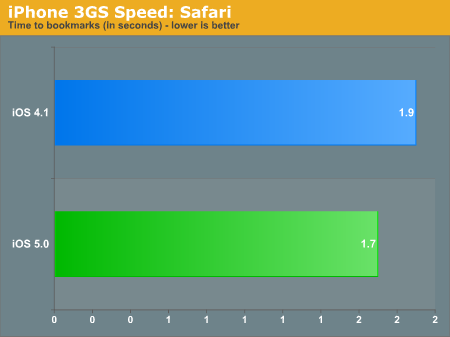
This is the amount of time between the launch of the Safari app and when the Bookmarks list popped up. iOS 5 brings a small improvement over iOS 4.1.
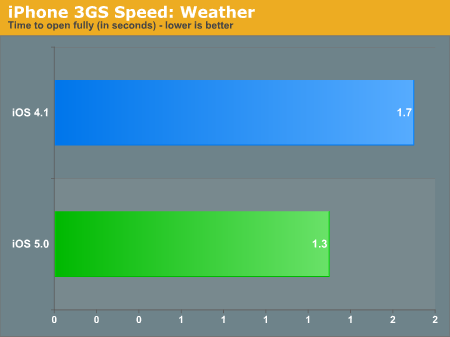
iOS 5 brings up Cupertino's weather marginally more quickly than in iOS 4.1.
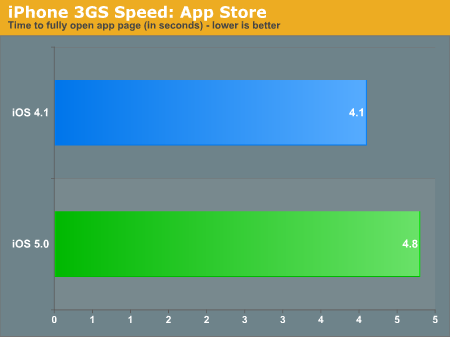
For this test, we looked up an app that had already been installed to the phone, closed the App Store, cleared it from the multitasking tray, re-opened the app, and waiting for the app's page to load again. It should be noted that while most other tests timed pretty consistently across multiple runs, we encountered the most variance between runs in this test - results were as low as 4.0 seconds and as high as 6.1 seconds. To get a reasonably representative number here, we did ten runs and averaged the results. The majority of the time, you're looking at a slight slowdown in the App Store compared to iOS 4.1.
If you've bought an iPhone 3GS since the iPhone 4 was introduced (or if you’re getting one for free now), you're not going to get burned the way that people who bought a 3G in the spring of 2010 did. The 3GS lacks the processing oomph of newer handsets, but is still mercifully responsive to user input. Apps launch quickly. Text entry is lag-free. The 3GS’s hardware and the extra time that Apple has had to optimize iOS 5 make upgrading easy to recommend, and the app launch and JavaScript benchmarks relative to iOS 4 back that up.
First generation iPad
The original iPad has the same Apple A4 SoC as the iPhone 4, but like the 3GS and third and fourth gen iPod Touches, it has only 256MB of memory. This doesn’t really hold it back though - iOS 5 seems to be pretty similar to iOS 4 from a hardware requirement standpoint, unlike the jump from iOS 3 to iOS 4.
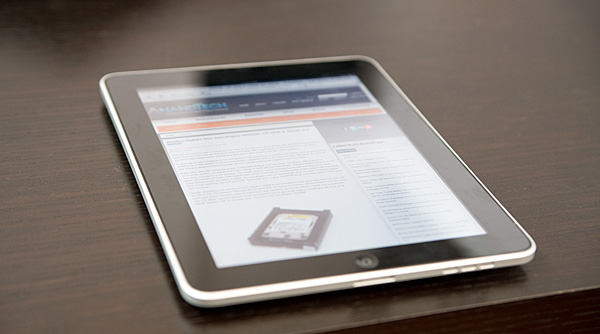
Basically everything that’s been updated in the iPad 2 version of iOS 5 makes the jump back to legacy; the notifications center, iMessage, iCloud, updated versions of Safari, Mail and Music, etc. Things that don’t make it include the camera and FaceTime updates (for obvious reasons), the new four-finger multitouch gestures (though other single finger swipe-based gestures still work), AirPlay mirroring (due to hardware requirements), and the ability to play 1080p video (also due to hardware requirements).
All of Apple’s devices running Cortex/ARM v7 processors are supported by iOS 5, and based on our findings with the iPhone 3GS and the original iPad, they’re more than capable of running it well.










86 Comments
View All Comments
Brian Klug - Tuesday, October 18, 2011 - link
That's true, however we've measured and talked about the size of iMessage messages - read/delivery reports are 53 bytes (which is literally almost entirely just overhead from JSON and APNS), and messages range upwards in size from there up to 853 bytes before being fragmented across a few different APNS.By that math, it's going to take 245,856 maximum length (853 byte) iMessages to eat up your 200 MB data plan.
-Brian
steven75 - Monday, October 31, 2011 - link
iMessage defaults back to SMS if it hasn't been sent after X seconds. In theory, this means you shouldn't have to worry about congestion because Apple thought of this for you.FoTacTix - Tuesday, October 18, 2011 - link
I was hoping for a battery life comparison in the review. Maybe I missed it? My battery life seemed to be much worse with imessage turned on on my Verizon iPhone 4.Dug - Tuesday, October 18, 2011 - link
Great review!The most important update for me was mirroring to the Apple TV, and I think Apple would sell millions of Apple TV's if they promoted this.
I enjoyed airplay before, but now that it works with every app is incredible.
I enjoy being able to put everything through my stereo and TV. Things like Pandora, MOG, videos, games, etc. is so nice and very easy. Garage Band is actually fun now that I don't have to plug into my stereo. No other product can come close to this. I have several Apple TV's now throughout the house and can control everything from my iPad.
It makes me wish that they made a 16x9 iPad. (But with my TV's I'm able to do a little stretch so it's not so bad)
jsd6 - Tuesday, October 18, 2011 - link
You can easily delete items from Reading List - swipe to delete on iphone/ipad, click the "X" icon on desktop Safari.You can do Wifi sync without being plugged in - it just isn't automatic. The wording on the iDevice is definitely confusing. As soon as your device is within wifi range of your Mac, the device will show up in iTunes as if it were connected via a cable. You can click Sync on iTunes, or initiate it from the phone. I've actually found to be too slow for my tastes so I stick with the cable. At least now the phone is still usable while the syncing is happening. That's a big step in the right direction!
Galatian - Tuesday, October 18, 2011 - link
The one thing that really made me angry about the iOS update was the removal of the multitouch gestures for iPad 1 owners. I mean it worked in iOS 4 through an Xcode developer account, so Apple can't even say that the hardware is not powerful enough, like they do with Siri.What is even worse is the fact that they changed their website AFTER the update has been releases and people started complaining on their support forum. Now the American site states it is an iPad 2 feature only. Strangely enough the UK, Canadian, German, ... still quote the general iPad.
Also the change log for iOS 5 update never mentions this to be an iPad 2 only feature.
Apple has been known to artificially outdate their products, but they have down so quietly. This time they actually announced something and are now quietly changing stuff so it fits their business model...dumb move if you ask me.
steven75 - Monday, October 31, 2011 - link
I agree there was not a good reason to do that. I wouldn't want to be without multitouch gestures on an iPad. I never use the home button except to turn it on.lurker22 - Tuesday, October 18, 2011 - link
So there is no fix?I have to remember to send messages to people using their email address in order for it to be sure and deliver to all their iOS device? Which means I have to know what phones all my friends use which is nuts.
Why doesn't iMessage just route imessages sent to a cell number to all the values associated with the apple ID?
name99 - Friday, October 21, 2011 - link
Truth is, there are a HUGE number of rough edges associated with iCloud and all the related services. A different set of examples would be the duplicates of events in calendars, or the duplicates of contacts in Address Book; and there is no consistent mental model for how data is supposed to behave "in the cloud and on devices". Mail behaves one way, calendars and contacts another, iTunes music a third --- and I don't think any human understands how Notes are supposed to behave.My HOPE is that this is all teething troubles --- Apple was faced with a deadline --- they needed to get iPhone 4S out by a certain date --- and iCloud was rushed before various bits were quite ready. If this is so, hopefully we'll see the worst discrepancies resolved in iOS5.1 and OSX 10.7.3 in three months or so.
And if not --- well, that is NOT a good sign. Apple's whole value proposition is, of course, "it just works". And while Android seem unlikely to compete on that front soon, it is possible (not inevitable, but possible) that MS might actually get it right in Win 8, right enough at least to become the new press darling, the company whose cloud offerings make sense, unlike Apple whose every product behaves poorly and inconsistently across the cloud.
unixfg - Wednesday, October 19, 2011 - link
I don't really understand your claim here:"So regardless of how and where you’ve gotten your music from, if its there on the iTunes Store, it automatically gets legalized and added to your account..."
Do you mean to imply there is no distinction on Apple's servers as to the source of your Music? I know the AAC files you buy have a tag linking it to your account, and can't imagine they wouldn't keep track of the source.
That aside, I don't see how it would "legalize" anything. I'm a huge fan of your articles, and hate that this is the first time I've felt the need to register and comment, but...
<citation needed>